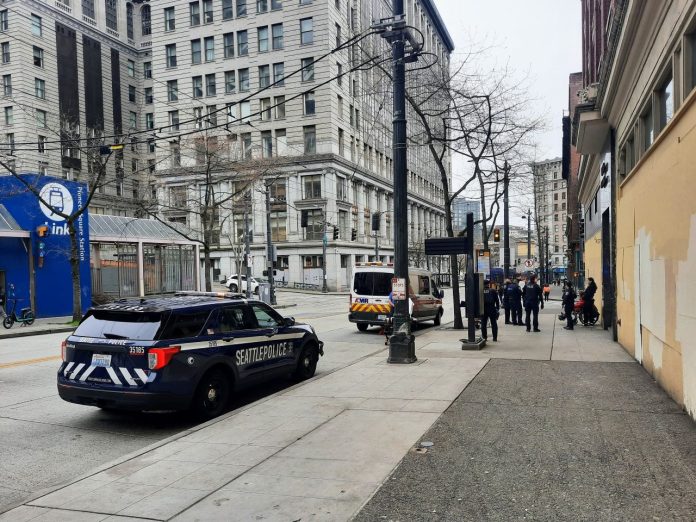
Seattle’s road to a non-police alternative to address its behavioral health crisis has been a long, convoluted one.
This month the new Community Assisted Response and Engagement (CARE) department will launch its dual dispatch pilot program, consisting of teams of two civilians, some of whom are behavioral health providers, who can be dispatched alongside sworn Seattle Police Department (SPD) officers. This new program has hired six responders thus far, and the pilot program has been allocated $1.8 million in the Mayor’s proposed 2024 budget.
Unfortunately, this is not the alternative mental health crisis response most police accountability advocates and prison abolitionists have been asking for since 2020 and the racial reckoning that summer of protests brought. It’s not the civilianized crisis response alternative that polls consistently show Seattleites overwhelmingly support.
Advocates have been interested in community-led alternative response programs that would limit contact of vulnerable community members, particularly Black and Indigenous people, with SPD, a department that to this day struggles with racial bias and has long been under a federal consent decree for a pattern of excessive use of force. The data shows Black people are disproportionately affected by crisis response in Seattle, and Crosscut also reported that while only 2.2% of calls for service in Seattle in 2017 and 2018 were crisis calls, those calls accounted for 25% of SPD officers’ use of force; a notable example of this was when officers shot and killed Charleena Lyles in 2017.

To avoid this racialized violence and the inevitably tragic results, advocates wanted mental health professionals, social workers, and other trained community members to make the initial contact when engaging with those experiencing mental health crises. We know the mere presence of police officers often further escalates the crisis, and police shouldn’t be asked to respond to every social problem our communities face simply by dint of their existence.
Furthermore, a study by the Treatment Advocacy Center showed people with untreated mental illness are 16 times more likely to be killed during a police encounter and are involved in one out of four police shootings, a number corroborated by a Washington Post database.
The presence of police also tends to criminalize mental illness and substance abuse disorder instead of treating them as health issues, an approach we can see, for example, in increasing rates of mental health disorders in prison inmates at Rikers. People with a mental health disorder are 10 times more likely to be incarcerated than hospitalized.
During his press conference about the new CARE Department, Mayor Harrell compared the dual dispatch pilot to programs in four other cities: Eugene, Denver, Albuquerque, and Durham. But unlike these four programs, Seattle’s program has not been designed to limit police contact with vulnerable communities.
Councilmember Andrew Lewis first mentioned the possibility of Seattle developing an emergency response program like Eugene’s CAHOOTS back in July of 2020. CAHOOTS has been running since 1989; promoted as an alternative response program to mental health crises that doesn’t involve dispatching an officer with a gun. Its responder teams only call for police backup about 2% of the time. While they sometimes respond with an officer, Eugene’s teams are also able to be dispatched on their own, a key difference with Seattle’s dual dispatch pilot.
Albuquerque, like Seattle, have been under their own consent decree since 2014 for a pattern of excessive use of force. However, their alternative response program received $11.7 million in its 2023 budget and consists of more than 70 responders – because unlike Seattle, Albuquerque took the 2020 call for reducing contact with the police seriously. Their teams respond to calls related to homelessness, substance abuse, and mental health, as well as calls regarding things like used needles and abandoned vehicles, and they tout themselves as a non-law enforcement-led response that utilizes a public health approach. Again, these teams are not dual dispatch in that they are allowed to answer calls on their own.

The alternative response programs in both Durham and Denver both answer calls without police present as well.
SPD has shown a particular reluctance to part with answering some of their 911 calls, in spite of the fact they are in the midst of a staffing shortage that is part of a nation-wide trend of people not being interested in becoming police officers. SPD brass have repeatedly emphasized the City’s goal of shrinking average response times to seven minutes or less for high priority urgent calls — a mythical mark we are led to equate with safety — and yet they stubbornly hold on to responding to lower priority calls even though it spreads resources thin.
SPD contracted with the National Institute for Criminal Justice Reform (NICJR) to produce a report analyzing Seattle’s 911 calls that was delivered in June of 2021. The report found nearly 80% of SPD calls were non-criminal with only 8% associated with any kind of felony, and that 49% of calls could be answered by a civilian without a gun.
SPD immediately pushed back on the report they themselves had commissioned, saying they felt only 12% of 911 calls could be answered without a police officer, a number they shrank even further in May of 2022 in anticipation of the release of their Risk Managed Demand (RMD) report that September. Their insistence on the necessity of the risk report allowed them to stall the creation of an alternative response for more than a year, when other comparable American cities were already scaling up their initial pilots.
The RMD report established a matrix looking at the likelihood and severity of injury by 911 call type; perhaps its most noteworthy feature was that SPD had to manually upgrade or downgrade this risk for more than 50% of call types, calling into question the accuracy of the model.
In a particularly noteworthy exchange at a public safety committee meeting, Lewis brought up Denver’s STAR program, saying SPD’s risk report suggested calls answered by STAR should be handled by co-response instead. Dan Eder, who is Mayor Harrell’s policy director, responded that the risk report couldn’t answer questions of this kind as it wasn’t determinative of the most appropriate call types to assign to a new program – even though the new program had been stalled for over a year waiting for the RMD report that was supposed to serve this very purpose.
All of the foot-dragging – from the previous and current mayoral administrations as well as SPD and the Seattle Police Officers Guild (SPOG) – has finally resulted in a watered down alternative response program that isn’t allowed to answer calls without a sworn officer being dispatched simultaneously, while also being severely limited in which call types it is allowed to answer.
Councilmember Herbold is more sanguine about the new dual dispatch pilot, having repeatedly described it differently than Mayor Harrell. She says police will sometimes be able to stage nearby or even just be situationally aware of the calls via dispatch while not being actually present. As recently as the budget meeting on September 27, she suggested many pilots have begun in this way and moved towards a more independent model as police realized their presence wasn’t necessary for the calls.
But given the host of failed promises related to both this program and to “reimagining public safety” in general, advocates are rightfully wary of whether SPD and SPOG will allow this pilot to become more independent over time.
The unpleasant truth is that any alternative emergency response program can only succeed if community resources are properly funded. Alternative response teams need to refer people to housing, overdose prevention centers, post-overdose stabilization centers, and behavioral health providers, among other services. When such services aren’t adequately funded – as they are not in Mayor Harrell’s proposed 2024 budget – alternative response teams won’t have enough help available to offer to those in need.
Community-led alternative response – response to mental health crises that don’t involve police with guns – is one step towards creating more equitable public safety, but it cannot hope to address our social problems all on its own.
Amy Sundberg is the publisher of Notes from the Emerald City, a weekly newsletter on Seattle politics and policy with a particular focus on public safety, police accountability, and the criminal legal system. She also writes science fiction, fantasy, and horror novels. She is particularly fond of Seattle’s parks, where she can often be found walking her little dog.

